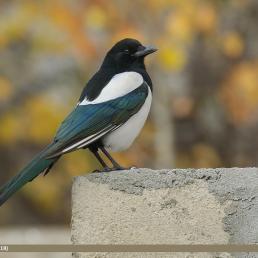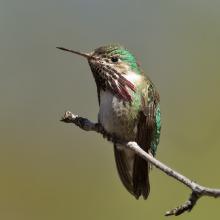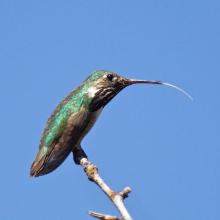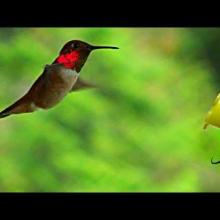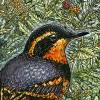

Join BirdNote tomorrow, November 30th!
Illustrator David Sibley and actor H. Jon Benjamin will face off in the bird illustration battle of the century during BirdNote's Year-end Celebration and Auction!
Hummingbirds use their long tongues to sip nectar from flowers. They’re able to roll their tongues into a tube-like shape. Since the 1800s, scientists thought those tongues worked through capillary action, like how water instantly rises into a straw in a full cup. But when scientists spent years using slow-motion cameras to capture hummingbirds drinking in greater detail, they uncovered a completely different story: the tongues act like a tiny but powerful pump.
BirdNote®
The Surprising Secret of Hummingbird Tongues
Written by Conor Gearin
Michael Stein: This is BirdNote.
[Calliope Hummingbird humming and calling, ML224276291]
Hummingbirds use their long tongues to sip nectar from flowers. They’re able to roll their tongues into a tube-like shape. Since the 1800s, scientists thought those tongues worked through capillary action, like how water instantly rises into a straw in a full cup. This happens passively: the water is attracted to the surface, against gravity.
But when scientists spent years using slow-motion cameras to capture hummingbirds drinking in greater detail, they uncovered a completely different story. The tongues aren’t just passively drawing up nectar — they act like a tiny but powerful pump.
[Calliope Hummingbird humming and calling, ML224276291]
Basically, hummingbirds use their tongues a bit like a bulb syringe or baster. First, the hummingbird flattens the tongue before putting it in the nectar. Then, once in contact with the liquid, the tongue expands, sucking the nectar inside. Finally, the hummingbird whips the tongue back to drink the mouthful.
The whole process repeats many times per second. Actively pumping their nectar lets hummingbirds drink about three times faster than if they just used their tongues like straws. While it’s a surprising adaptation, it’s no surprise to find that the tongues of hummingbirds are just as busy as their bodies.
[Calliope Hummingbird humming, ML224276291]
For BirdNote, I’m Michael Stein.
###
Producer: Mark Bramhil
Producer: Sam Johnson
Managing Editor: Jazzi Johnson
Managing Producer: Conor Gearin
Content Director: Jonese Franklin
Bird sounds provided by The Macaulay Library of Natural Sounds at the Cornell Lab of Ornithology, Ithaca, New York. Calliope Hummingbird ML224276291 recorded by Paul Fenwick.
BirdNote’s theme was composed and played by Nancy Rumbel and John Kessler.
© 2024 BirdNote September 2024
Narrator: Michael Stein
ID# hummingbird-11-2024-09-12 hummingbird-11
Reference:
https://royalsocietypublishing.org/doi/10.1098/rspb.2015.1014
